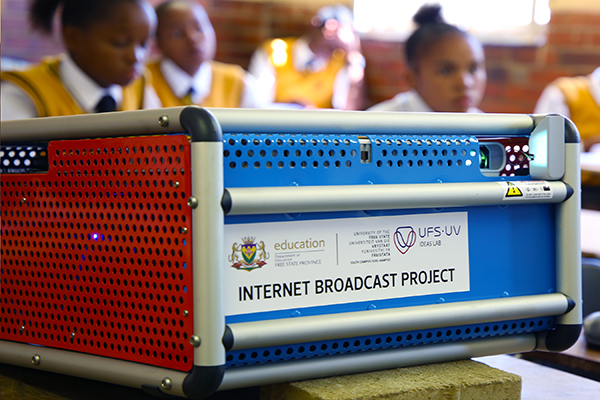
The AIO device as deployed in an IBP school.
Photo: Elrieka van Dalen
The IDEAS Lab on our South Campus supports learners in 83 schools by means of academic videos transmitted via the Internet Broadcast Project (IBP) and its own custom-built All-in-One (AIO) device. The project is a collaboration between UFS and the Department of Education in the Free State. It includes support for Mathematics, Physical Science, Life Science, Economics, Accounting, and Geography.
The AIO was purpose-built by the team at IDEAS Lab to facilitate the delivery of video lectures from highly-qualified teachers to identified schools. It comprises a projector, speakers, and a computer, which are housed in a custom-made, hard-wearing frame. The AIO is then set up at each school to which lessons are broadcast.
On-the-job training for educators
Educators have not been overlooked, either. UFS was the very first university to provide an Advanced Certificate in Teaching in a fully digital format, the ACT Online programme. It is designed for practicing teachers to upskill themselves in order to better address the needs in the classroom, not only advancing their career, but strengthening their knowledge, competencies, and subject specialisation as well. Ultimately, this leads to an improved quality of education, which has a profound impact on multitudes of students around South Africa.
CSIR joint initiative
Coupled with these projects is a new joint initiative termed ICT For Education. This project sees the CSIR collaborating with the national Department of Education, the Department of Rural Development and Land Reform, and the UFS. For this project, 24 primary and secondary schools in South Africa were identified to promote technological advancement in the education sector. Tablet computers have been allocated and already deployed at these schools, to learners as well as nearly 400 teachers.
South Campus is involved in the training of the teachers and learners in the use of the tablets in the classroom and other educational opportunities. In addition, training for 48 unemployed young people who will be providing first-line support began in March at a school in Thaba Nchu. The course on IT support is structured in such a way that anyone in the community can take it, starting out with topics such as My role in the community.